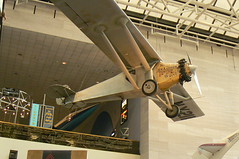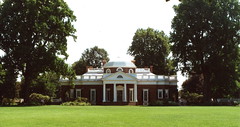Travel to Phoenix
Monday, November 30th, 2009Welcome to the land of the sun!
Phoenix, the fifth largest city in the USA, is the most glorious destination (more…)
Welcome to the land of the sun!
Phoenix, the fifth largest city in the USA, is the most glorious destination (more…)
By Guest Author Peggy Bradshaw; Photos by George Bradshaw
The Smithsonian National Air and Space Museum (NASM) maintains the largest collection of historic air and spacecraft in the world. Located in Washington, DC on the National Mall, it also has a companion facility at the Steven F. Udvar-Hazy Center near Washington Dulles Airport at Chantilly, VA.
The space shuttle Enterprise is housed at the Udvar-Hazy Center, as is one of Amelia Earhart’s planes.
The NASM holds in trust some 50,000 objects, including air craft, space craft, engines, rockets, uniforms, space suits, balloons and artwork. The Wright Brothers 1903 Flyer is on display with related artifacts. A whole section is dedicated to the Wright Brothers with original and replica flying machines.

Charles Lindbergh's Spirit of St. Louis
This is the day in the United States that families give thanks. But, it has grown far beyond what the original Pilgrims could ever have envisioned. We have a humongous feast that can take days to prepare. We truly do have much for which to be thankful.
Years ago, I traveled to Plymouth Rock where the Pilgrims landed and it had become extremely commercialized. There were little stands with the usual gimcracks and souvenirs.
Buying things seems to be what everyone thinks about when they consider traveling. And, I admit, I have purchased my share of souvenirs, too.
Somehow, the anticipation of seeing a new place and the sense of wonder and discovery has now been dulled by security checks and the many rules and regulations that now govern our travel.
In this blog, we have tried to feature places where we have enjoyed the travel, the people and the indelible scenes that have enriched our lives.
The reason I decided to publish a travel blog was that the newspaper for which I write, a small city’s paper, had asked me to cover travel. They decided they only wanted to feature local places, which left a whole world of great destinations I wasn’t able to share.
So, that led to the beginning of this travel blog.
The blog is now eight months old – almost old enough to have given birth to a real human baby. Have we done a good job? Does anyone want to share his/her experiences?
Would anyone like to offer comments other than the spammers who perpetually leave messages – or in Russian, which I cannot read?
So, I am asking for people to respond and participate. Should we continue the blog? Will you help us by supporting the blog through response and checking out our store?
We’re open to new experiences and new people. We’re always thankful for them.
Please give us some feedback!
And, have a wonderful holiday season to those who celebrate holidays in the next month. To those who don’t have holidays, please accept our understanding that people have different cultures and ways of experiencing the world. We would love to hear from you, as well!
May you have health, love and joy in your life and a chance to travel to the places that enlighten, enliven and excite you!
Warmest regards,
Shelley Gillespie
Publisher and Editor
Traveltipsandadventures.com
PS The new photos at the top of the blog give you some new places to view. Oregon and Las Vegas are featured – two great destinations!
Okay, you’ve got some money, you’ve got some land up on a hill, and you’ve got some brains. But, what you don’t have is a place to live! What will you do? What will you do?
Thomas Jefferson, never at loss to come up with a new idea, decided he was going to build a house on the hill as the centerpiece to his 5,000-acre plantation.
And talk about privacy! You can’t see it from the road, even if you know where to look.
Preparation of the site began in 1768 with construction beginning the following year. With approximately 11,000 sq. ft. of living space, this is not your basic suburban master-planned community house. Monticello was designed by Jefferson after a visit to Europe. The Roman neoclassic design contains forty-three rooms following a remodeling expansion completed in 1809.
Much of the construction material came from the land around the house. The window glass came from Europe and about one-third of the glass now in the house is original.

Monticello - Thomas Jefferson's home
Of interest is Jefferson’s bed, which he designed after seeing alcove beds during his time in France. Taking the idea of beds built into walls upon his return from Europe, Jefferson redesigned Monticello, adding an alcove bed to his bedroom, but leaving both sides open. This connected his bedroom with his study. So, Jefferson was never totally hidden away in his bedroom, but was able to access both rooms easily. Obviously, Jefferson was not a man to rest easily.
Tours of the house run constantly throughout the day with timed tickets, so it is best to visit other areas of Monticello following your background tour.
Those background tour areas include the Gardens, dependencies, Mulberry Row and Jefferson’s gravesite.
Tickets are available throughout the day on a first come-first served basis. Tours of the house begin every 10 minutes.
House Tour/Grounds: Nov. – Feb. $15.00 / March – October $20.00
Age 6-11: $8.00
Hours Vary – See Website for calendar of hours.
Tomorrow – Come back for a retrospect on our blog and some things to be thankful for.
There’s something about a college town. I’m not talking about New York City, Boston, or Los Angeles, but rather those small to mid-sized towns that cater to, or are intricately involved with, the day–to-day operations of the campus.
Virginia has several such towns, Lexington (Washington & Lee University), Williamsburg (College of William & Mary), Blacksburg (Virginia Poly Tech), Radford (Radford University), even Farmville (Longwood University) are a few of the ten such towns that are labeled “college towns.”
But, my pick for this article is Charlottesville.
Home to the University of Virginia, designed by United States President and signer of the Declaration of Independence, Thomas Jefferson, Charlottesville is just over an hour from Richmond, and easily accessible by car or plane. Current population of just under 50,000 makes this a small college town with amenities that you might not find in other towns of this size. (more…)
A greatly expanded visitor’s center is now located at the former Tredegar Iron Works overlooking the James River. The former foundry pushed out cannons and high quality munitions for the Confederacy during the Civil War along with steam locomotives. Fortunately the building survived the burning of Richmond in April 1865 as Confederate troops were ordered to destroy munitions plants as they evacuated the city.
Rumor has it that the owner of the building “hired” armed guards to keep the arsonists away. Thus, Tredegar is one of only a few buildings that survived the burning of Richmond. (more…)
By Guest Author Peggy Bradshaw; Photos by George Bradshaw
Commonly called just “Virginia Tech,” the Virginia Polytechnic Institute and State University is located on 2,600 acres in Blacksburg, VA and contains 125 buildings. It was founded in 1872 as a public grant college and has worked its way up to be one of the top public universities in the United States.

Virginia Tech "Hokie" stone building
If you think the Civil War ended nearly 150 years ago, you’ve never been to Richmond, Virginia. It’s a place where people still have the last name of Lee and are most likely direct descendents of the famous General who almost, or at least could have, worked for the “other side.”
Although Robert E. Lee was not born in Richmond (actually at his family home of Stratford Hall near Lerty, Virginia), nor is he even buried there (that would be in a chapel at Washington & Lee University in Lexington, Virginia), his legacy lives on if not more than in a large statue on Monument Avenue. (more…)
It’s the Capitol of Virginia, but it has also been the Capitol of the Confederacy, a claim no other U.S Capitol can come close to. Although the Civil War has been over for 144 years, the past lives on alongside the present.
As a former resident of the city for several years, it’s always interesting to come back and re-visit just why you lived somewhere, and maybe even why you left. In the case of Richmond, I relocated there for a job and left for the same reason.
Richmond is a mix of a modern and also a “stuck in the past” city. The latter would be their Civil War heritage.
But, that shouldn’t stop anyone from visiting as there are many things to see and do and you don’t have to see a single battlefield, Civil War or Revolutionary War, if you don’t want to, and still have a great time.
Are you into literature? Edgar Allen Poe lived in Richmond for over 13 years. The Poe Museum is located on Broad Street (Poe didn’t actually live in the house, but nearby). Furniture from his home, as well as manuscripts, first editions and personal belongings, are on display.
Architecture? How about a 15th century English estate (Agecroft Hall) that was bought at auction, crated and shipped from Lancashire, England to Richmond, and reassembled on the banks of the James River.
Famous speeches? Revolutionary leader Patrick Henry wasn’t shy about speaking. He gave his famous “stick it to King George” speech, “Give Me Liberty, or Give Me Death” at St. John’s Church in Richmond.
www.historicstjohnschurch.org/hist_main.htm
Monuments? How about … Monument Avenue? Northwest of downtown Richmond you’ll find Robert E. Lee on a horse … J.E.B. Stuart, on a horse … Stonewall Jackson, on a horse … Jefferson Davis (President of the Confederate States of America), not on a horse.
Anyone notice a theme … and we’re not talking about the horses.
And then, there is Matthew Fontaine Maury. Who? Seriously, WHO?
And finally, a slightly controversial choice for an avenue with statues of Confederate soldiers — we have
Arthur Ashe, professional tennis player, born and raised in Richmond.
Even if you don’t like statues, the architecture along the avenue ranges from English Tudor, Georgian, Italian, and Art Deco on either side of center islands of huge trees and green grass. It’s the kind of street they don’t build anymore.
Historic Theatres with a Pipe Organ? The Byrd Theatre in Carytown, a retail shopping area northwest of downtown was opened in 1928. Included in its 1,300 seat configuration is a balcony and a Wurlitzer Pipe Organ that opens the show on Saturday evenings by rising from the basement to the stage in front of the screen.
You can’t buy tickets ahead of time, they don’t show previews, and the movies aren’t first run … but at $1.99, I’m not going to complain!
http://www.visitrichmondva.com/
NEXT TIME: We’ll take a trip back in time and look at the Civil War history of Richmond and what remains today.
If we seem to be in rhapsodies over Corvallis, you’re right – and we have another activity to share. We happened into an event that features local vineyards paired with local stores. Great idea, right? Well, it was! (more…)